check engine INFINITI G35 2006 Service Manual
[x] Cancel search | Manufacturer: INFINITI, Model Year: 2006, Model line: G35, Model: INFINITI G35 2006Pages: 344, PDF Size: 6.81 MB
Page 276 of 344

Check the fluid level in each cell. It
should be between the UPPER LEVEL
q 1
and LOWER LEVEL
q 2
lines.
If it is necessary to add fluid, add only
distilled water to bring the level to the in-
dicator in each filler opening. Do not over-
fill.
1. Remove the cell plugs
q A
.
2. Add distilled water up to the UPPER
LEVEL
q 1
. If the side of the battery is not visible,
the electrolyte level can be checked
through each filler opening as illus-
trated.
3. Tighten cell plugs
q A
.
Vehicles operated in high temperatures or
under severe conditions require frequent
checks of the battery fluid level. JUMP STARTING If jump starting is necessary, see ªJump
startingº in the ª6. In case of emergencyº
section. If the engine does not start by
jump starting, the battery may have to be
replaced. Contact an INFINITI dealer.DI0137MA SDI1480
8-18 Maintenance and do-it-yourself
w 06.1.4/V35-D/V5.0
X
Page 277 of 344
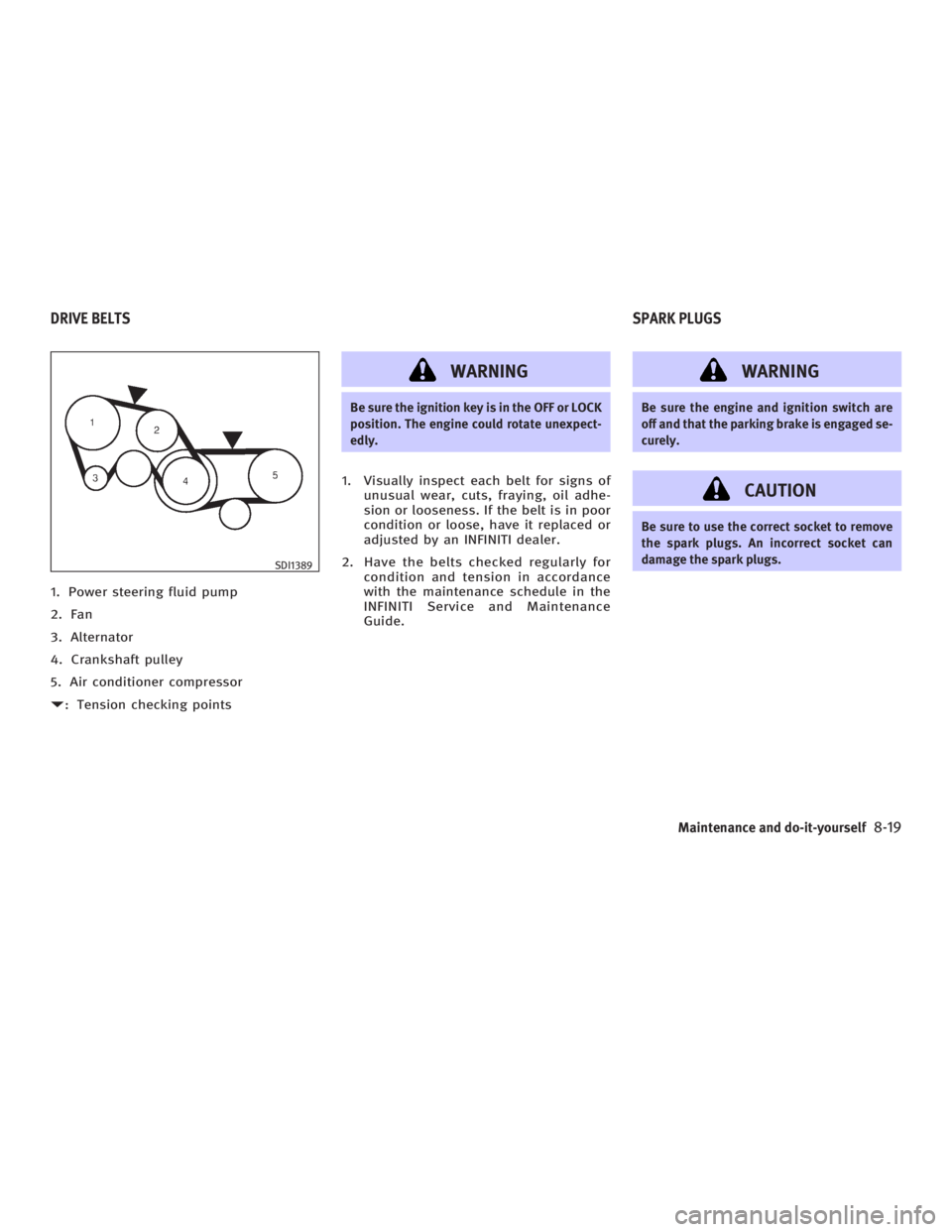
1. Power steering fluid pump
2. Fan
3. Alternator
4. Crankshaft pulley
5. Air conditioner compressor
D : Tension checking points WARNING Be sure the ignition key is in the OFF or LOCK
position. The engine could rotate unexpect-
edly.
1. Visually inspect each belt for signs of
unusual wear, cuts, fraying, oil adhe-
sion or looseness. If the belt is in poor
condition or loose, have it replaced or
adjusted by an INFINITI dealer.
2. Have the belts checked regularly for
condition and tension in accordance
with the maintenance schedule in the
INFINITI Service and Maintenance
Guide.
WARNING Be sure the engine and ignition switch are
off and that the parking brake is engaged se-
curely.
CAUTION Be sure to use the correct socket to remove
the spark plugs. An incorrect socket can
damage the spark plugs.SDI1389
DRIVE BELTS SPARK PLUGS
Maintenance and do-it-yourself
8-19
w 06.1.4/V35-D/V5.0
X
Page 281 of 344

CHECKING PARKING BRAKE
Pedal type From the released position, depress the
parking brake pedal slowly and firmly,
and check the notches between the initial
and final position of the pedal
q A
.Ifitis
out of the range, see an INFINITI dealer.
Range
q A
: 2 to 3 notches under a de-
pressing force of 44 lb (196
N) Lever type From the released position, pull the park-
ing brake lever up slowly and firmly. If the
number of clicks is out of the range
q A
,
see an INFINITI dealer.
Range
q A
: 6 to 7 clicks under pulling force
of 44 lb (196 N)
CHECKING BRAKE PEDAL With the engine running, check the dis-
tance
q A
between the upper surface of
the pedal and the metal floor. If it is out
of the range shown below, see an INFINITI
dealer.
Distance
q A
: Under depressing force of
110 lb (490 N) Automatic
Transmission model Manual
Transmission model
3.74 in (95 mm) or more 3.54 in (90 mm) or moreSDI1391F SDI1447B DI1020MO
PARKING BRAKE AND BRAKE PEDAL
Maintenance and do-it-yourself
8-23
w 06.1.4/V35-D/V5.0
X
Page 282 of 344
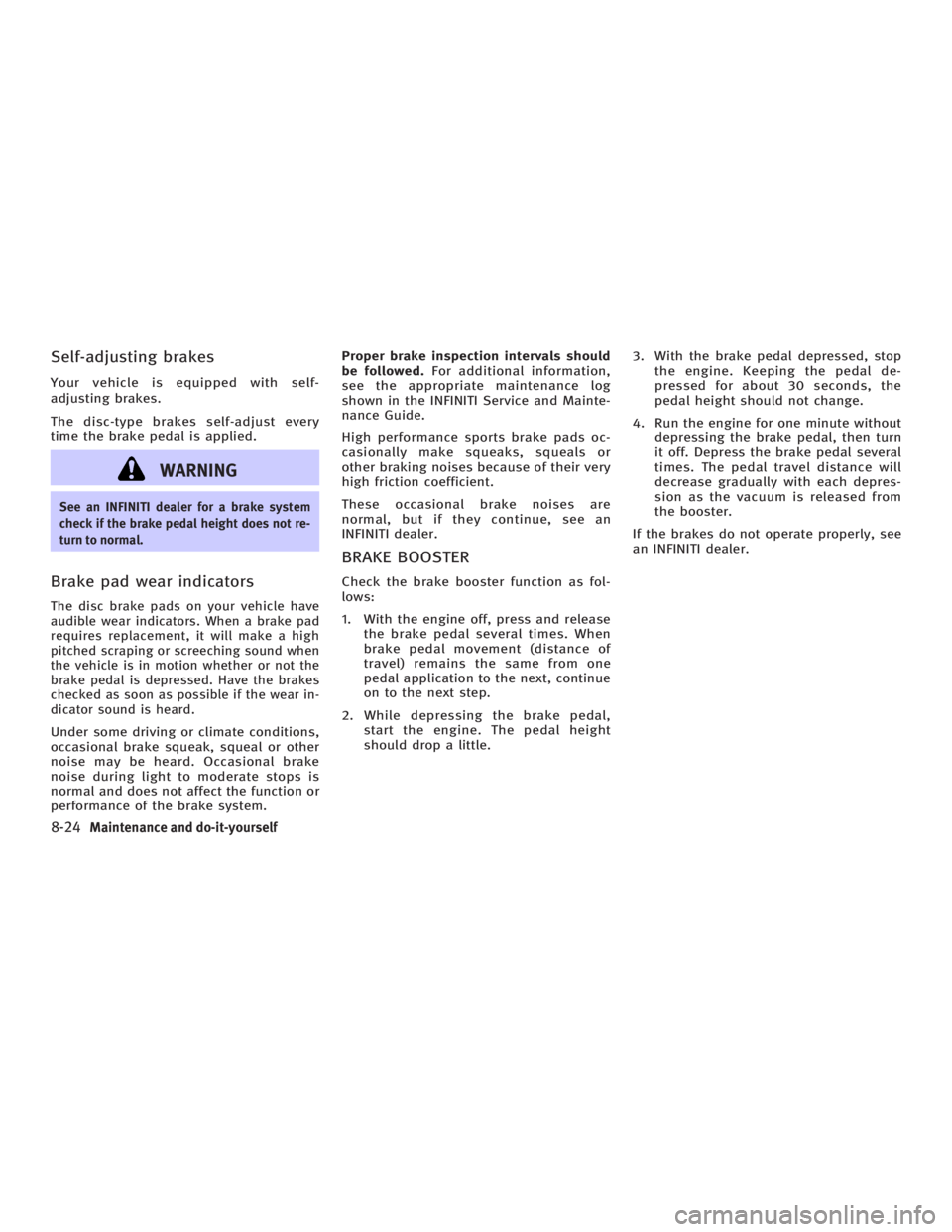
Self-adjusting brakes Your vehicle is equipped with self-
adjusting brakes.
The disc-type brakes self-adjust every
time the brake pedal is applied.
WARNINGSee an INFINITI dealer for a brake system
check if the brake pedal height does not re-
turn to normal.
Brake pad wear indicators The disc brake pads on your vehicle have
audible wear indicators. When a brake pad
requires replacement, it will make a high
pitched scraping or screeching sound when
the vehicle is in motion whether or not the
brake pedal is depressed. Have the brakes
checked as soon as possible if the wear in-
dicator sound is heard.
Under some driving or climate conditions,
occasional brake squeak, squeal or other
noise may be heard. Occasional brake
noise during light to moderate stops is
normal and does not affect the function or
performance of the brake system. Proper brake inspection intervals should
be followed. For additional information,
see the appropriate maintenance log
shown in the INFINITI Service and Mainte-
nance Guide.
High performance sports brake pads oc-
casionally make squeaks, squeals or
other braking noises because of their very
high friction coefficient.
These occasional brake noises are
normal, but if they continue, see an
INFINITI dealer.
BRAKE BOOSTER Check the brake booster function as fol-
lows:
1. With the engine off, press and release
the brake pedal several times. When
brake pedal movement (distance of
travel) remains the same from one
pedal application to the next, continue
on to the next step.
2. While depressing the brake pedal,
start the engine. The pedal height
should drop a little. 3. With the brake pedal depressed, stop
the engine. Keeping the pedal de-
pressed for about 30 seconds, the
pedal height should not change.
4. Run the engine for one minute without
depressing the brake pedal, then turn
it off. Depress the brake pedal several
times. The pedal travel distance will
decrease gradually with each depres-
sion as the vacuum is released from
the booster.
If the brakes do not operate properly, see
an INFINITI dealer.
8-24 Maintenance and do-it-yourself
w 06.1.4/V35-D/V5.0
X
Page 283 of 344
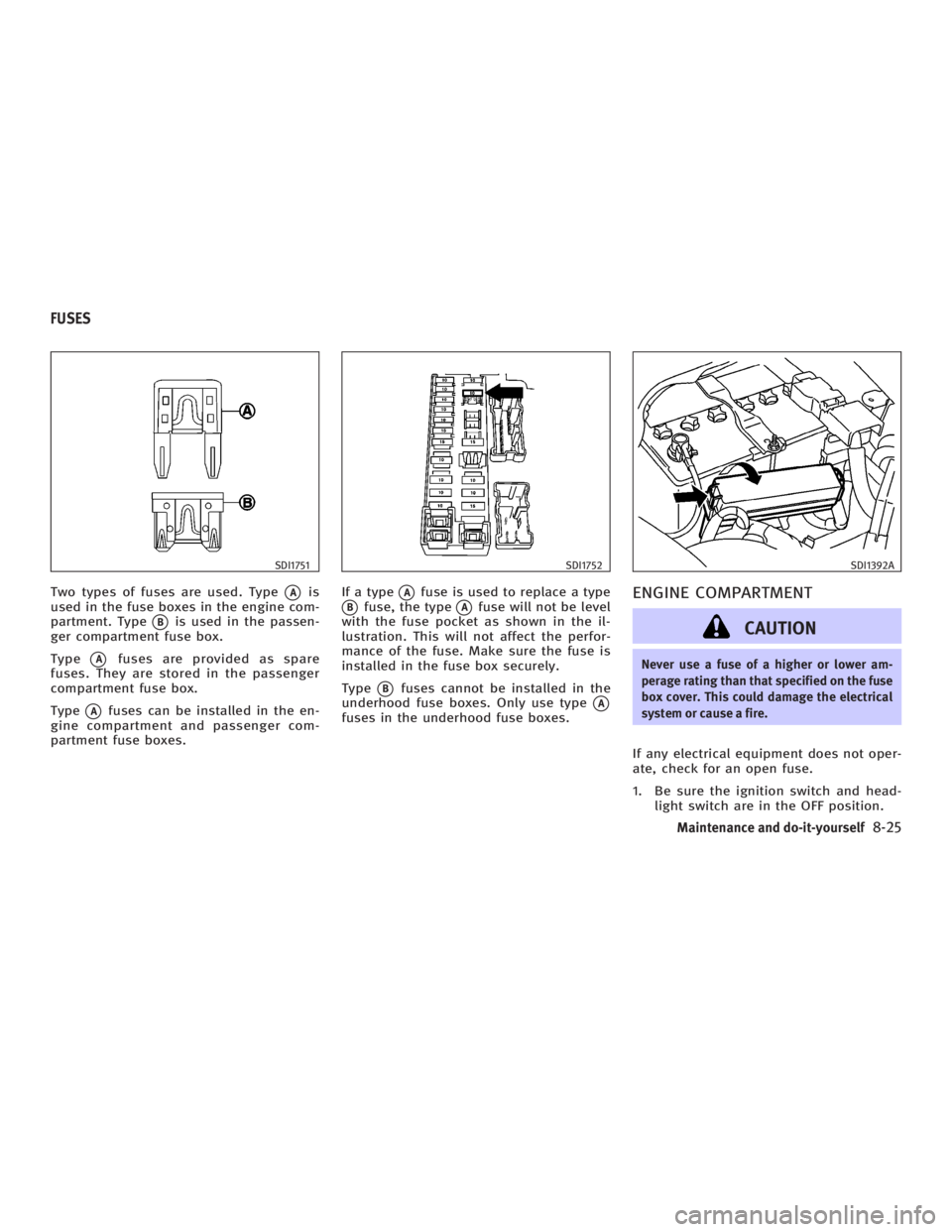
Two types of fuses are used. Type
q A
is
used in the fuse boxes in the engine com-
partment. Type
q B
is used in the passen-
ger compartment fuse box.
Type
q A
fuses are provided as spare
fuses. They are stored in the passenger
compartment fuse box.
Type
q A
fuses can be installed in the en-
gine compartment and passenger com-
partment fuse boxes. If a type
q A
fuse is used to replace a type
q B
fuse, the type
q A
fuse will not be level
with the fuse pocket as shown in the il-
lustration. This will not affect the perfor-
mance of the fuse. Make sure the fuse is
installed in the fuse box securely.
Type
q B
fuses cannot be installed in the
underhood fuse boxes. Only use type
q A
fuses in the underhood fuse boxes. ENGINE COMPARTMENT
CAUTION Never use a fuse of a higher or lower am-
perage rating than that specified on the fuse
box cover. This could damage the electrical
system or cause a fire.
If any electrical equipment does not oper-
ate, check for an open fuse.
1. Be sure the ignition switch and head-
light switch are in the OFF position.SDI1751 SDI1752 SDI1392A
FUSES
Maintenance and do-it-yourself
8-25
w 06.1.4/V35-D/V5.0
X
Page 284 of 344
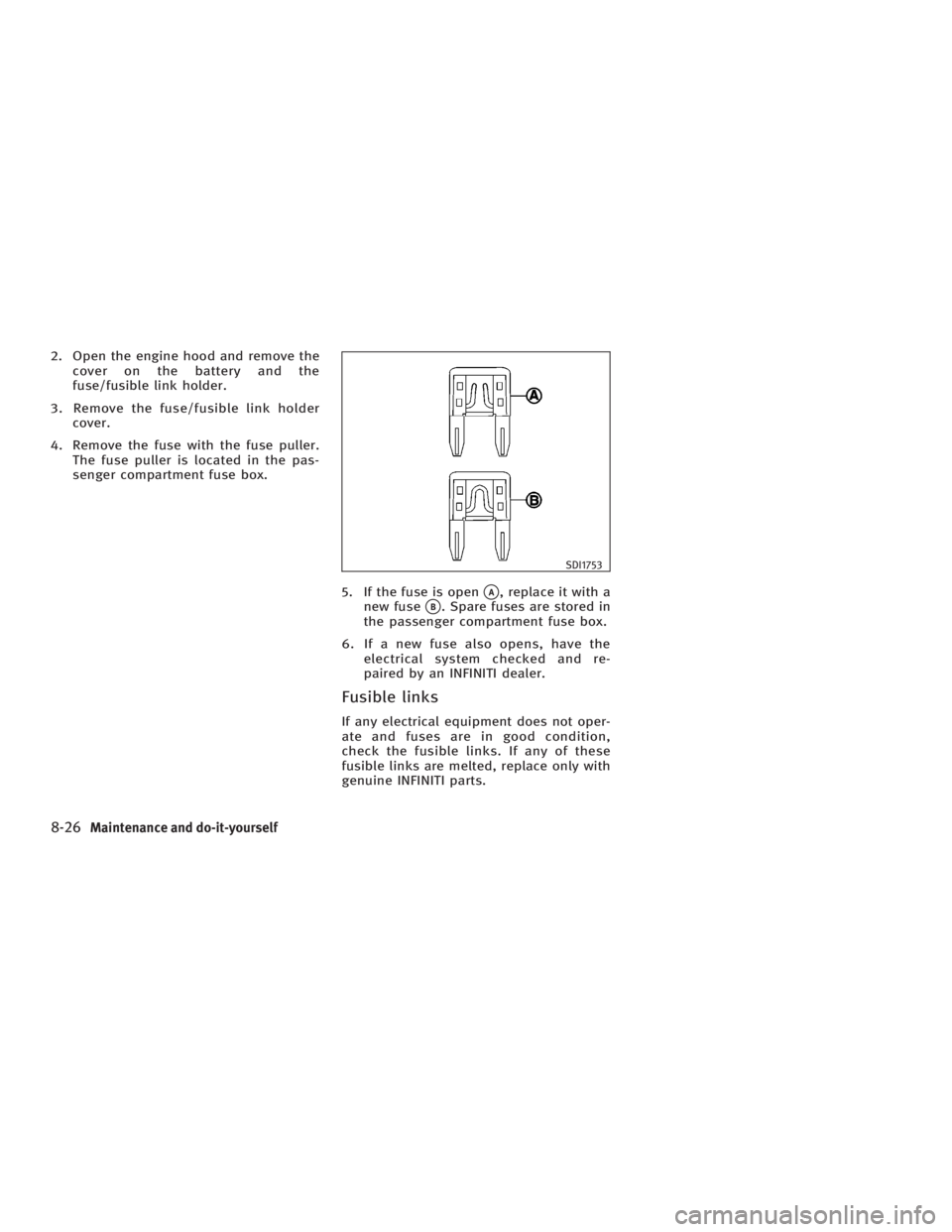
2. Open the engine hood and remove the
cover on the battery and the
fuse/fusible link holder.
3. Remove the fuse/fusible link holder
cover.
4. Remove the fuse with the fuse puller.
The fuse puller is located in the pas-
senger compartment fuse box.
5. If the fuse is open
q A
, replace it with a
new fuse
q B
. Spare fuses are stored in
the passenger compartment fuse box.
6. If a new fuse also opens, have the
electrical system checked and re-
paired by an INFINITI dealer.
Fusible links If any electrical equipment does not oper-
ate and fuses are in good condition,
check the fusible links. If any of these
fusible links are melted, replace only with
genuine INFINITI parts. SDI1753
8-26 Maintenance and do-it-yourself
w 06.1.4/V35-D/V5.0
X
Page 310 of 344

performance problems and/or fuel system
damage.
O The fuel must be unleaded and have an
octane rating no lower than that recom-
mended for unleaded gasoline.
O If an oxygenate-blend, excepting a
methanol blend, is used, it should con-
tain no more than 10% oxygenate.
(MTBE may, however, be added up to
15%.)
O If a methanol blend is used, it should
contain no more than 5% methanol
(methyl alcohol, wood alcohol). It
should also contain a suitable amount
of appropriate cosolvents and corro-
sion inhibitors. If not properly formu-
lated with appropriate cosolvents and
corrosion inhibitors, such methanol
blends may cause fuel system damage
and/or vehicle performance problems.
At this time, sufficient data is not avail-
able to ensure that all methanol blends
are suitable for use in INFINITI vehicles.
If any driveability problems such as en-
gine stalling and hard hot starting are ex-
perienced after using oxygenate-blend fu-
els, immediately change to a non-
oxygenate fuel or a fuel with a low blend
of MTBE. Take care not to spill gasoline during refu-
eling. Gasoline containing oxygenates can
cause paint damage.
E-85 fuel E-85 fuel is a mixture of approximately
85% fuel ethanol and 15% unleaded gaso-
line. E-85 can only be used in a Flexible
Fuel Vehicle (FFV). Do not use E-85 fuel in
your vehicle. U.S. government regulations
require fuel ethanol dispensing pumps to
be identified by a small, square, orange
and black label with the common abbre-
viation or the appropriate percentage for
that region.
Aftermarket fuel additives INFINITI does not recommend the use of
any aftermarket fuel additives (i.e. fuel in-
jector cleaner, octane booster, intake
valve deposit removers, etc.) which are
sold commercially. Many of these addi-
tives intended for gum, varnish or deposit
removal may contain active solvent or
similar ingredients that can be harmful to
the fuel system and engine.
Octane rating tips Using unleaded gasoline with an octane
rating lower than recommended can cause persistent, heavy spark knock. (Spark
knock is a metallic rapping noise.) If se-
vere, this can lead to engine damage. If
you detect a persistent heavy spark knock
even when using gasoline of the stated oc-
tane rating, or if you hear steady spark
knock while holding a steady speed on
level roads, have your dealer correct the
condition. Failure to correct the condition
is misuse of the vehicle, for which INFINITI
is not responsible.
Incorrect ignition timing will result in
knocking, after-run or overheating. This in
turn may cause excessive fuel consump-
tion or damage to the engine. If any of the
above symptoms are encountered, have
your vehicle checked at an INFINITI dealer
or other competent service facility.
However, now and then you may notice
light spark knock for a short time while ac-
celerating or driving up hills. This is no
cause for concern, because you get the
greatest fuel benefit when there is light
spark knock for a short time under heavy
engine load.
9-4 Technical and consumer information
w 06.1.4/V35-D/V5.0
X
Page 327 of 344
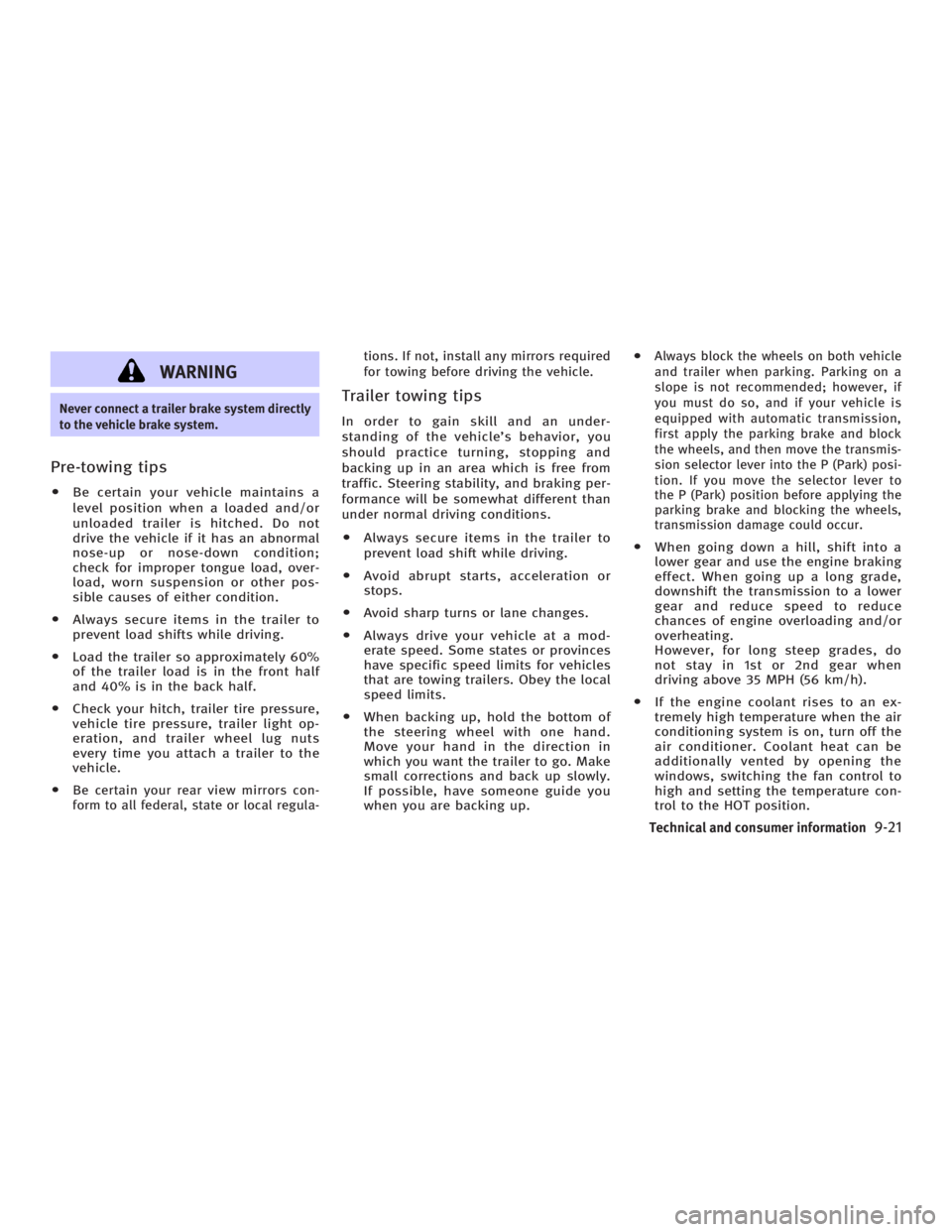
WARNINGNever connect a trailer brake system directly
to the vehicle brake system.
Pre-towing tips O Be certain your vehicle maintains a
level position when a loaded and/or
unloaded trailer is hitched. Do not
drive the vehicle if it has an abnormal
nose-up or nose-down condition;
check for improper tongue load, over-
load, worn suspension or other pos-
sible causes of either condition.
O Always secure items in the trailer to
prevent load shifts while driving.
O Load the trailer so approximately 60%
of the trailer load is in the front half
and 40% is in the back half.
O Check your hitch, trailer tire pressure,
vehicle tire pressure, trailer light op-
eration, and trailer wheel lug nuts
every time you attach a trailer to the
vehicle.
O Be certain your rear view mirrors con-
form to all federal, state or local regula- tions. If not, install any mirrors required
for towing before driving the vehicle.
Trailer towing tips In order to gain skill and an under-
standing of the vehicle's behavior, you
should practice turning, stopping and
backing up in an area which is free from
traffic. Steering stability, and braking per-
formance will be somewhat different than
under normal driving conditions.
O Always secure items in the trailer to
prevent load shift while driving.
O Avoid abrupt starts, acceleration or
stops.
O Avoid sharp turns or lane changes.
O Always drive your vehicle at a mod-
erate speed. Some states or provinces
have specific speed limits for vehicles
that are towing trailers. Obey the local
speed limits.
O When backing up, hold the bottom of
the steering wheel with one hand.
Move your hand in the direction in
which you want the trailer to go. Make
small corrections and back up slowly.
If possible, have someone guide you
when you are backing up. O Always block the wheels on both vehicle
and trailer when parking. Parking on a
slope is not recommended; however, if
you must do so, and if your vehicle is
equipped with automatic transmission,
first apply the parking brake and block
the wheels, and then move the transmis-
sion selector lever into the P (Park) posi-
tion. If you move the selector lever to
the P (Park) position before applying the
parking brake and blocking the wheels,
transmission damage could occur.
O When going down a hill, shift into a
lower gear and use the engine braking
effect. When going up a long grade,
downshift the transmission to a lower
gear and reduce speed to reduce
chances of engine overloading and/or
overheating.
However, for long steep grades, do
not stay in 1st or 2nd gear when
driving above 35 MPH (56 km/h).
O If the engine coolant rises to an ex-
tremely high temperature when the air
conditioning system is on, turn off the
air conditioner. Coolant heat can be
additionally vented by opening the
windows, switching the fan control to
high and setting the temperature con-
trol to the HOT position.
Technical and consumer information
9-21
w 06.1.4/V35-D/V5.0
X
Page 328 of 344
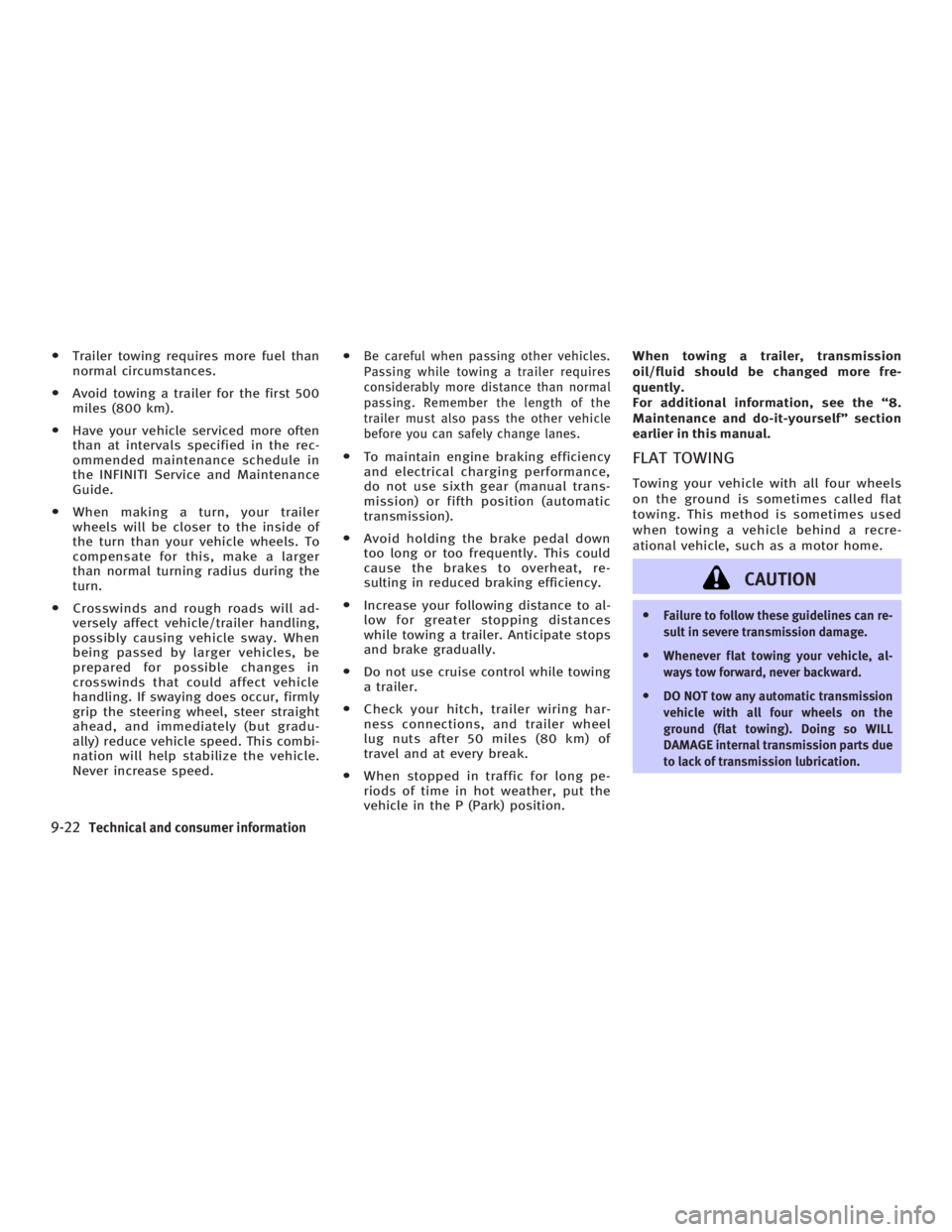
O Trailer towing requires more fuel than
normal circumstances.
O Avoid towing a trailer for the first 500
miles (800 km).
O Have your vehicle serviced more often
than at intervals specified in the rec-
ommended maintenance schedule in
the INFINITI Service and Maintenance
Guide.
O When making a turn, your trailer
wheels will be closer to the inside of
the turn than your vehicle wheels. To
compensate for this, make a larger
than normal turning radius during the
turn.
O Crosswinds and rough roads will ad-
versely affect vehicle/trailer handling,
possibly causing vehicle sway. When
being passed by larger vehicles, be
prepared for possible changes in
crosswinds that could affect vehicle
handling. If swaying does occur, firmly
grip the steering wheel, steer straight
ahead, and immediately (but gradu-
ally) reduce vehicle speed. This combi-
nation will help stabilize the vehicle.
Never increase speed. O Be careful when passing other vehicles.
Passing while towing a trailer requires
considerably more distance than normal
passing. Remember the length of the
trailer must also pass the other vehicle
before you can safely change lanes.
O To maintain engine braking efficiency
and electrical charging performance,
do not use sixth gear (manual trans-
mission) or fifth position (automatic
transmission).
O Avoid holding the brake pedal down
too long or too frequently. This could
cause the brakes to overheat, re-
sulting in reduced braking efficiency.
O Increase your following distance to al-
low for greater stopping distances
while towing a trailer. Anticipate stops
and brake gradually.
O Do not use cruise control while towing
a trailer.
O Check your hitch, trailer wiring har-
ness connections, and trailer wheel
lug nuts after 50 miles (80 km) of
travel and at every break.
O When stopped in traffic for long pe-
riods of time in hot weather, put the
vehicle in the P (Park) position. When towing a trailer, transmission
oil/fluid should be changed more fre-
quently.
For additional information, see the ª8.
Maintenance and do-it-yourselfº section
earlier in this manual.
FLAT TOWING Towing your vehicle with all four wheels
on the ground is sometimes called flat
towing. This method is sometimes used
when towing a vehicle behind a recre-
ational vehicle, such as a motor home.
CAUTION O Failure to follow these guidelines can re-
sult in severe transmission damage.
O Whenever flat towing your vehicle, al-
ways tow forward, never backward.
O DO NOT tow any automatic transmission
vehicle with all four wheels on the
ground (flat towing). Doing so WILL
DAMAGE internal transmission parts due
to lack of transmission lubrication.
9-22 Technical and consumer information
w 06.1.4/V35-D/V5.0
X
Page 331 of 344

A vehicle equipped with All-Wheel Drive
(AWD) should never be tested using a two
wheel dynamometer (such as the dyna-
mometers used by some states for emis-
sions testing), or similar equipment. Make
sure you inform test facility personnel
that your vehicle is equipped with AWD
before it is placed on a dynamometer. Us-
ing the wrong test equipment may result
in transmission damage or unexpected
vehicle movement which could result in
serious vehicle damage or personal in-
jury.
Due to legal requirements in some states/
areas, your vehicle may be required to be
in what is called the ªready conditionº for
an Inspection/Maintenance (I/M) test of
the emission control system.
The vehicle is set to the ªready conditionº
when it is driven through certain driving
patterns. Usually, the ªready conditionº
can be obtained by ordinary usage of the
vehicle.
If a powertrain system component is re-
paired or the battery is disconnected, the
vehicle may be reset to a not ªready con-
ditionº. Before taking the I/M test, check
the vehicle's inspection/maintenance test
readiness condition. Turn the ignition switch ON without starting the engine. If
the Malfunction Indicator Lamp (MIL)
comes on steady for 20 seconds and then
blinks for 10 seconds, the I/M test condi-
tion is ªnot readyº. If the MIL does not
blink after 20 seconds, the I/M test condi-
tion is ªreadyº. If the MIL indicates the
vehicle is in a ªnot readyº condition, drive
the vehicle through the following pattern
to set the vehicle to the ready condition.
If you cannot or do not want to perform
the driving pattern, an INFINITI dealer can
conduct it for you.
WARNING Always drive the vehicle in a safe and pru-
dent manner according to traffic conditions
and obey all traffic laws.
1. Start the engine. Allow the engine to
idle until the engine coolant tempera-
ture gauge needle points between the
C and H (normal operating tempera-
ture).
2. Accelerate the vehicle to 55 MPH (88
km/h), then quickly release the accel-
erator pedal completely and keep it re-
leased for at least 10 seconds. 3. Quickly depress the accelerator pedal
for a moment, then drive the vehicle at
a speed of 53 to 60 MPH (86 to 96
km/h) for at least 9 minutes.
4. Stop the vehicle. Leave the engine
running.
5. Accelerate the vehicle to 35 MPH (55
km/h) and maintain the speed for 20
seconds.
6. Repeat steps 4 and 5 at least 10 times.
7. Accelerate the vehicle to 55 MPH (88
km/h) and maintain the speed for at
least 3 minutes.
8. Stop the vehicle. Place the automatic
transmission selector lever in the ªPº
or ªNº position or the manual trans-
mission shift lever in the ªNº position.
9. Turn the engine off.
10. Repeat steps 1 through 8 at least one
more time.
If step 1 through 7 is interrupted, repeat
the preceding step. Any safe driving mode
is acceptable between steps. Do not stop
the engine until step 7 is completed.READINESS FOR INSPECTION/
MAINTENANCE (I/M) TEST (US only)
Technical and consumer information
9-25
w 06.1.4/V35-D/V5.0
X